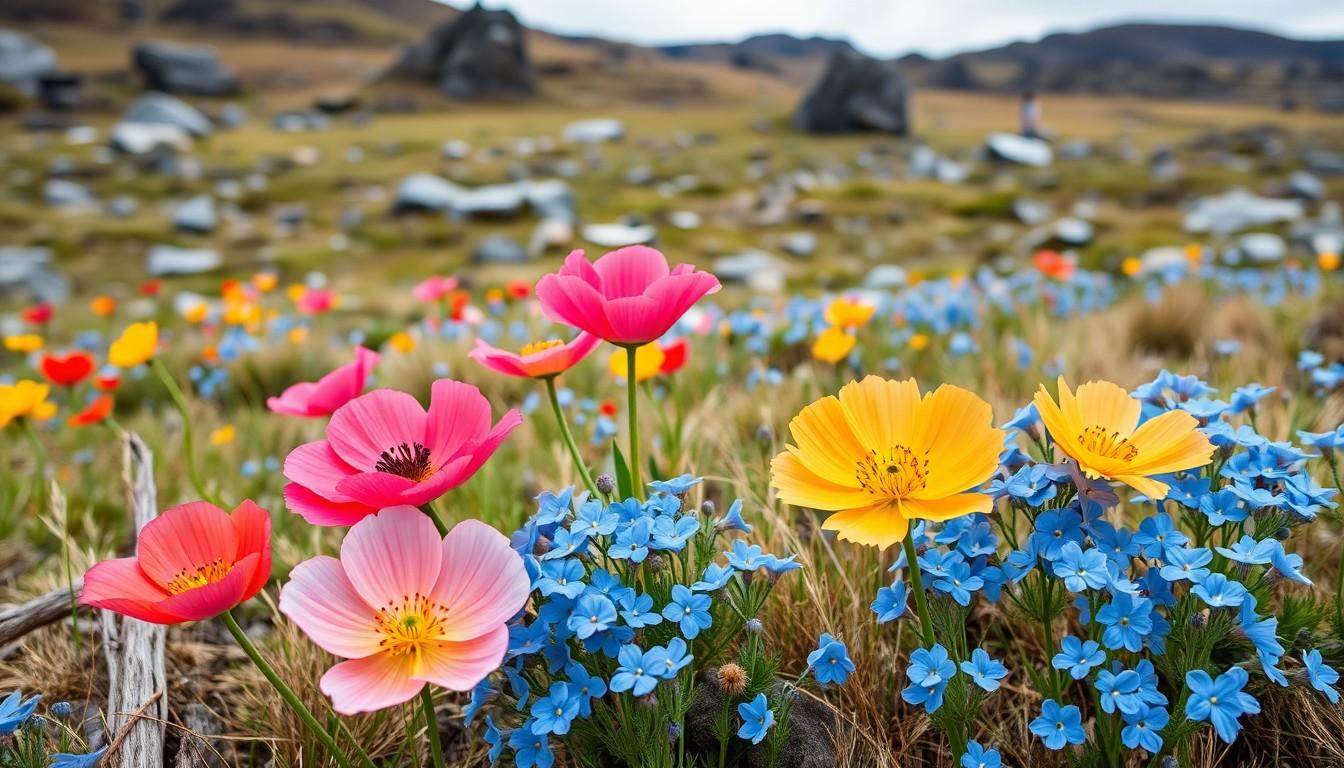The Best Fluffy Pancakes recipe you will fall in love with. Full of tips and tricks to help you make the best pancakes.

Tundra Flowers: Discover the Hidden Resilience of Nature’s Arctic Beauties
In the world of flora, tundra flowers are the unsung heroes, thriving in conditions that would make most plants throw in the towel. Picture a landscape where the ground is frozen solid, yet these resilient blooms manage to burst forth in a dazzling display of color. They’re not just surviving; they’re flourishing against the odds and proving that beauty can indeed flourish in the harshest of environments.
Overview of Tundra Flowers
Tundra flowers display remarkable resilience in extreme conditions. Found in Arctic and alpine regions, they adapt to low temperatures, strong winds, and short growing seasons. These plants bloom during the brief summer months, taking advantage of the limited sunlight.
Colorful blooms like the Arctic poppy and moss campion dot the landscape, captivating those who venture into these harsh environments. Many tundra flowers possess unique adaptations, such as small leaves that minimize water loss. They also feature deep roots that anchor them against fierce winds and help them access nutrients in nutrient-poor soil.
Species diversity does exist, with approximately 1,700 flowering plants identified in the tundra ecosystems. Dominant types include perennial herbs and low-growing shrubs. Key adaptations allow these plants to survive below-freezing temperatures and a short growth period.
Pollination occurs primarily through wind and insects, despite environmental challenges. Some species like the purple saxifrage attract pollinators quickly during their brief blooming period. Most tundra flowers contain anti-freeze proteins, preventing damage from freezing temperatures.
Research indicates that climate change impacts tundra flowers, altering their blooming periods and distribution patterns. Studies show that some species may migrate northward as conditions warm, while others may face extinction. Observing these flowers provides insight into the delicate balance of tundra ecosystems and the impact of environmental changes. Vibrant and resilient, tundra flowers highlight nature’s wonders in extreme climates.
Types of Tundra Flowers

Tundra flowers encompass various species, showcasing unique adaptations to survive in extreme conditions. This section details the different types of tundra flowers prevalent in these harsh environments.
Perennial Species
Perennial species dominate tundra ecosystems, thriving for years in challenging climates. Arctic poppy exemplifies a resilient perennial, featuring bright yellow blooms that attract pollinators during the fleeting summer months. Saxifrages, another group of perennials, often blanket the ground with their vibrant colors. These plants resist harsh temperatures by forming rosettes that protect flowers and leaves from freezing. Some species, like the moss campion, develop dense mats, minimizing water loss and offering stability against fierce winds. Adaptations in these perennials highlight their ability to endure Arctic winters while standing out against the stark landscape.
Annual Species
Annual species in tundra environments complete their life cycle within a single growing season. Their growth is timed to maximize exposure to sunlight during the brief summer. An example includes the delicate Alpine forget-me-not, which showcases beautiful blue flowers. The annual primrose, characterized by bright yellow petals, also flourishes briefly before the onset of colder weather. These species often exhibit rapid germination and seed development, allowing them to reproduce quickly in short periods. Strategies like these enable annual flowers to make the most of limited sunlight, ensuring their presence in the tundra ecosystem for years to come.
Adaptations of Tundra Flowers
Tundra flowers possess numerous adaptations that enable survival in extreme conditions. These adaptations help them flourish where few other plants can thrive.
Cold Resistance
Cold resistance is crucial for tundra flowers. They often develop anti-freeze proteins, protecting cellular structures from freezing temperatures. Such proteins allow flowers like the Arctic poppy to bloom when temperatures hover around freezing. Many of these plants also have small leaves, reducing the surface area exposed to harsh elements. This feature minimizes water loss during long, cold periods. Some species store energy in roots and tubers, allowing rapid growth when conditions improve. Resilience becomes key in these harsh climates, particularly as snow continues to blanket the ground.
Drought Tolerance
Drought tolerance proves vital for tundra flowers. Limited water availability often arises when melted snow rapidly evaporates. To combat this, many species like moss campion develop deep roots, which anchor them securely in the soil while accessing water sources. Growth strategies include forming mat-like structures that help retain moisture in the root zone. Some flowers even exhibit adaptations that enable them to enter dormancy during dry spells, conserving energy until conditions improve. Such characteristics enhance survival chances in a landscape characterized by extreme fluctuations in moisture.
Ecological Importance of Tundra Flowers
Tundra flowers play a critical role in their ecosystems. They provide essential support for wildlife and stabilize soil in harsh climates.
Support for Wildlife
Tundra flowers serve as a crucial food source for various animals. Many herbivores, including reindeer and caribou, depend on these blooms during the short growing season. Pollinators such as bees and butterflies are attracted to vibrant flowers, ensuring the continuation of plant species through pollination. Additionally, these plants create habitats for insects that support larger wildlife. Small mammals also benefit from the cover provided by dense flower mats. Nutrients from decaying foliage enhance the soil, further benefiting diverse wildlife populations.
Soil Stabilization
Soil stabilization is another key benefit of tundra flowers. Deep root systems hold soil in place, preventing erosion from strong winds and rapid snowmelt. Vegetative cover reduces runoff, allowing water to percolate into the ground. Flowers’ mat-like structures assist in moisture retention during dry spells, ensuring soil health. They help maintain nutrient levels, promoting a balanced ecosystem. Overall, the presence of tundra flowers contributes to a stable and resilient landscape, essential for sustaining life in extreme conditions.
Cultivation and Conservation of Tundra Flowers
Cultivating tundra flowers presents unique challenges due to their specialized adaptations. Many gardeners attempt growing these species in controlled environments that mimic their natural habitats. Proper hydration remains essential, as many tundra flowers prefer well-drained soil to prevent root rot.
Conservation efforts play a critical role in preserving the delicate balance of tundra ecosystems. Organizations focus on protecting habitats from development and climate change impacts. Efforts include monitoring populations and restoring disturbed areas to support resilient plant communities.
In addition, scientists study the genetic diversity of tundra flowers, an important factor for survival. Understanding how different species adapt to their surroundings helps inform conservation strategies. Knowledge of their flowering behavior also aids in predicting responses to environmental changes.
Collaboration among conservationists, researchers, and local communities strengthens these initiatives. Community-driven projects often involve educating the public about the importance of tundra flowers and their ecosystems. Engagement encourages sustainable practices and supports broader conservation goals.
Regulating human activities in tundra regions is vital. Restrictions on pollution and land use help minimize disturbances that threaten these fragile ecosystems. Monitoring climate changes enables timely interventions to protect flowering plants at risk of extinction.
Preserving tundra flowers underscores the significance of biodiversity. Each species contributes uniquely to the overall health of the tundra ecosystem. Scientists advocate for comprehensive policies to ensure that these remarkable plants continue to thrive in their harsh environments.
Conclusion
Tundra flowers symbolize resilience and beauty in the harshest environments. Their unique adaptations allow them to thrive where few others can, playing a crucial role in maintaining the delicate balance of tundra ecosystems. As climate change poses new challenges, the survival of these remarkable plants becomes increasingly uncertain.
Efforts to conserve their habitats and understand their ecological significance are essential for preserving not only the flowers themselves but also the wildlife that depends on them. Observing these vibrant blooms offers a glimpse into nature’s tenacity and the intricate connections within these extreme landscapes. Protecting tundra flowers is vital for the health of our planet’s biodiversity and the future of these unique ecosystems.




